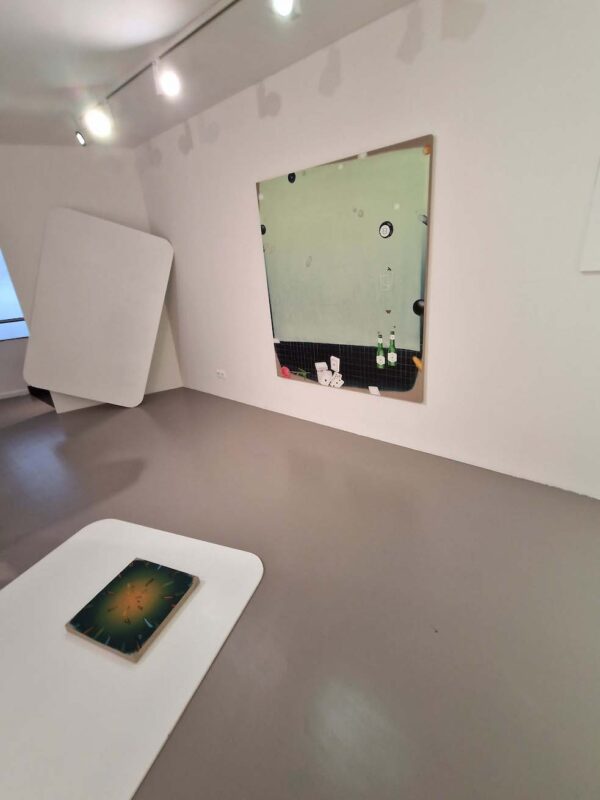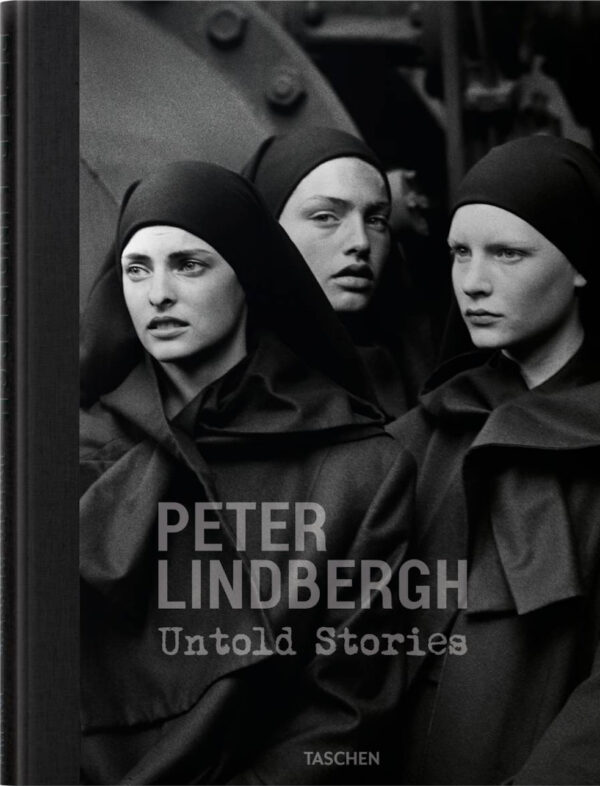We present you here a very intriguing exhibit which runs in Sion, Switzerland, in the cellars of the celebrated ‘Maison du Diable’. There your eyes meet the drawings of a genius who gave us his epoch-making films ‘Armacord’ and ‘Otto e Mezzo’: Frederico Fellini. A man who put his creativity and dreams on the screen, but also, and actually first of all, drew his creative and unique thoughts and images on paper. Actually, he started first with drawing, even before directing the film camera. Already in the ‘40s he started drawing comics for the Travasiio or the Marc’ Aurelio, a satirical magazine, and these drawings were also a tool to sharpen his creativity on the film set.
Hans Knol ten Bensel
He reverted to drawing time and again when he was deepening his self-expression. The caricatures, illustrated poems, depicting scenes between chaos and eros, put literally the setting and stage for the personalities and characters he created in his films. But there is also an altogether different set of drawings, which he made in the last year of his life, after a stroke he had at the Grand Hotel de Rimini. A few days later he was transferred to the rehabilitation department in Ferrara. There he was treated further by Doctor Anna Cantagallo, who has carefully kept the drawings he made during his recovery. These very drawings, which belong to her collection, are now on exhibit in Sion, at the Maison du Diable, until April 30th. Of course, there is a deeply personal, human story behind it, so read further…
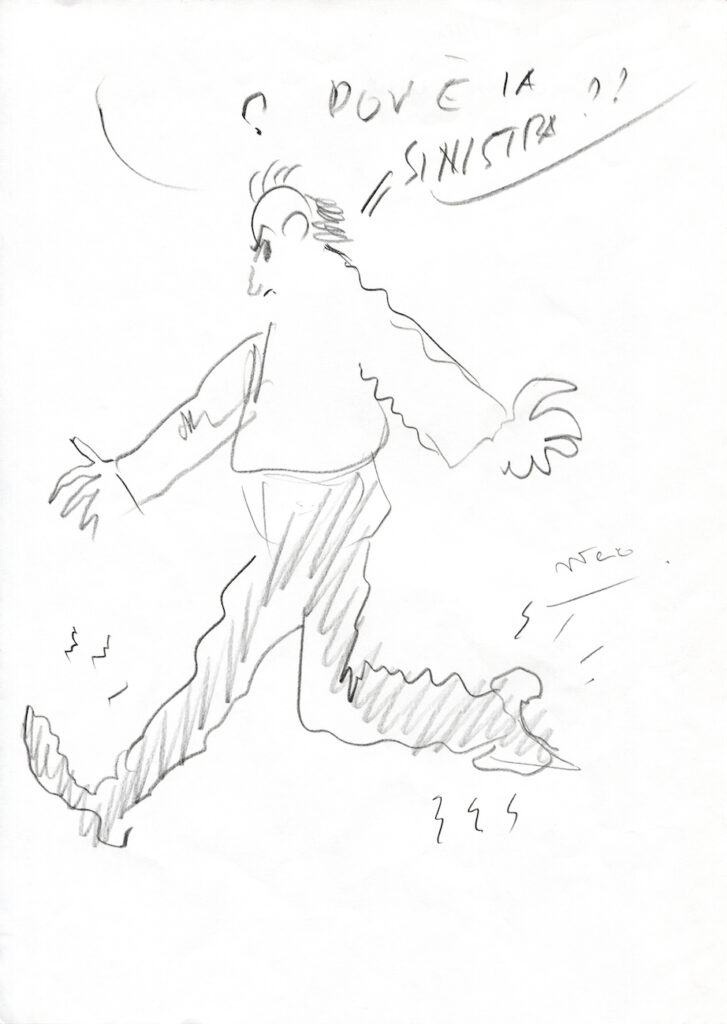
La Dottoressa Anna Catagallo remembers her days with Frederico Fellini very well. He was aware of his condition, and kept his full lucidity throughout his illness. Of course he knew moments of sadness, but his creative mind, inspiration, his genius and his irony allowed him to see his situation with tasteful humor. He would entertain the other patients, playing the clown of the group, as if they were his high school friends. With the physiotherapists, he complimented them abundantly on their appearance and he applauded them for their elegance. He felt pampered by them and he enjoyed every minute of it.
Between bouts of despair, Fellini would be upbeat and full of self-mockery about his own condition. He was keen to maintain a pleasant and playful atmosphere, when he was in high spirits.
The stroke blocked (initially) his left field of vision, and also his left hand was paralyzed. So he drew on the right side of the paper, and omitted details and contours on the left side of his drawings. The eagerness of his desire to draw was remarkable. Even between two sessions of drawing exercises he would not take a rest and just continued frantically to draw on any piece of paper he could lay his hands on. He knew his drawings were not perfect however, and he put this clearly: “My drawings are not as good as they could be”…
We interviewed Mme Anna Cantagallo, MD neurologist and neurosciences referee:
What do the drawings after his stroke tell you about him as an artist, as a creator of images and stories?
“Federico was a raging river, a continuous energy, his internal energy had to manifest it externally through drawings, stories told either through words or through images. He reproduced images he saw in the environment according to his style or created new images, even taking inspiration from his films. This allowed him to keep his creativity alive and also allowed him to create relationships with the people close to him in the hospital – friends, other patients, family members of patients, doctors – and therefore he also created the relationship through images.”
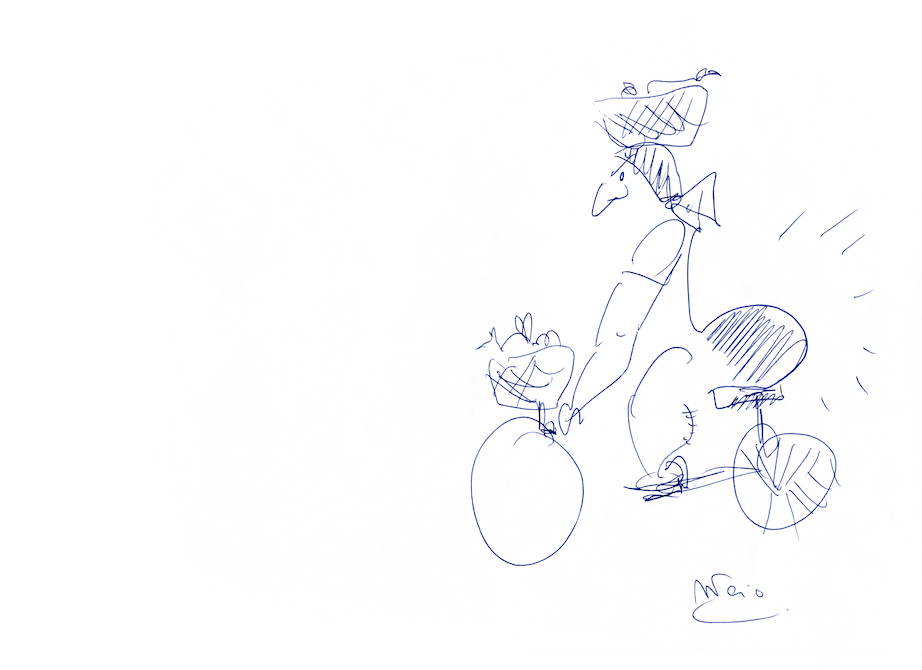
What did he project of himself in the figures he made in his drawings?
“The evolution in the phases of Federico’s drawings of the last two months is very clear. At the beginning he sees himself totally disintegrated, supported by other people on the way, in the erect position, or broken up as if his identity had disintegrated. He then progressively recomposes himself in the images that represent himself, however he always maintains a spatial hemi-neglect on the left, i.e. the image of himself on the left has neglect, therefore in the drawings the left side of his body is as if not reproduced, it is as if empty. Then, progressively the images become more and more complete and full of details and, at the end of the two months, they also become in colour. So, this is precisely the progression of his figures in the images, or rather of his representation in the images he draws. We have published its clinical history and its evolution in the scientific paper Cantagallo and Della Sala (1998) in the prestigious Cortex journal.”
His humor and joyfulness made him sustain his regrets and sorrows, in which drawings do you find this is most prevalent?
“His humor and joie de vivre can be seen very clearly in the images: they are caricatures, sarcastic sketches, details that also include some characters from his films. After all, these images often came to his mind even during dreams, therefore during the night, and then in the morning he immediately sketched the first images he remembered after the nocturnal dream, and we often find well-known characters in his drawings, as well as new creatures . The sense of humor is both self-irony (“I am supported by poles”, “I am supported by cable cars”, “I am supported by two “busty” nurses”, and so on), as well as the joy of living when I asked to draw a laid table. Instead of placing all the plates and dishes on the table to demonstrate how important his spatial left-handedness was (I expected him to put things to the right and not the left of the table), he actually placed a naked woman on the table and he represented himself as a little devil sitting in the pram with the pitchfork in his hand to be able to start his meal. And when I asked him “But isn’t there anything missing from the images?”, he added two candles, one for the buttock of the naked woman lying prone on the table.”
What do you think was his fundamental message to us, both as an artist and film maker?
“The message he leaves us is very clear: creativity remains very active even during pathology, during a disorder and each of us has an inner part that must also be manifested in illness. Therefore, creativity, the positive energy we have inside, but also self-irony, sarcasm of oneself and of others. Power is maintaining a relationship with other people, smiling even in pathology, looking for the humorous, if not comical side, even in a hospital, even in pain.”
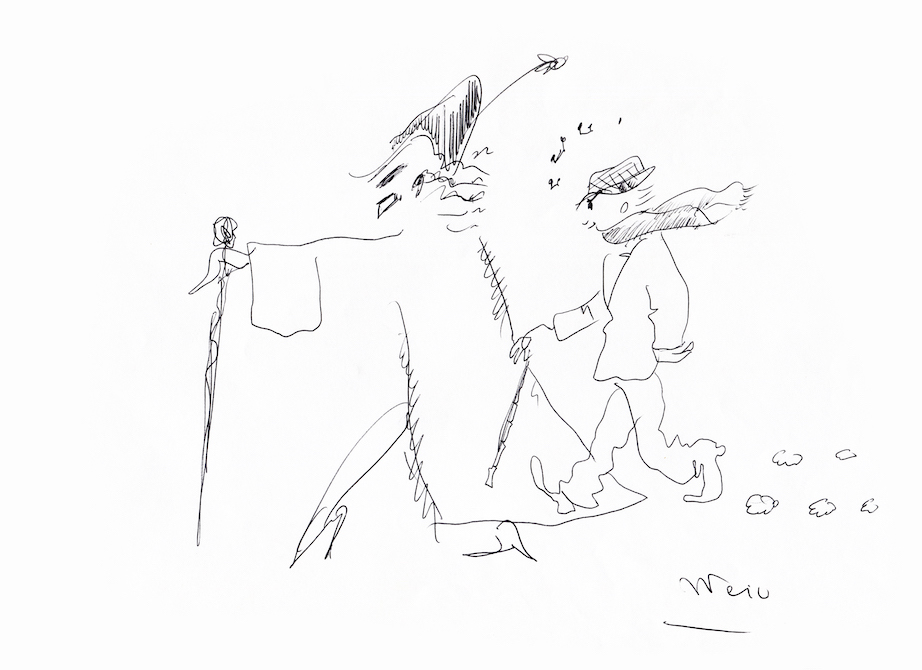
His legacy…
Of course, what Fellini has left to many of us was his enormous creativity, which he transmitted to all of us through his films. He inspired many, and indeed thousands have attended his funeral on November 3, 1993. Did you know that he is the only film director in the world to have received five Oscars? Four awards for his films, one for his whole career. He started, as we said, to make comical drawings in the ‘40s, and was much appreciated by the youth of his time. He made drawings for a satirical magazine, Marc’ Aurelio, and Many young collaborators of the magazine including Federico Fellini, Steno, Vittorio Metz, Ettore Scola, Cesare Zavattini, Age & Scarpelli, Ruggero Maccari, after the World War II started successful careers in the Italian film industry. The magazine gave him steady employment between 1939 and 1942, when he interacted with writers, gagmen, and scriptwriters.
In the catalogue accompanying the exhibition, there is an appraisal of the drawings by Frederico Fellini after his stroke by Joan Marie Kelly, Artist and Senior Lecturer at the Nanyang Technological University (NTU), School of Art Design and Media (ADM) in Singapore.
There are several accounts of quotes by Federico Fellini the world-renowned film maker, describing his experiences acclimating to a body he does not recognize after a stroke at seventy-three years old. From a personal perspective as an artist two essential impressions were strongest when studying the quotes. Firstly, he mourned his loss of autonomy and second, he was very open about his desire for connection. He describes his lack of ability to move his body in the ways he was accustomed to, as not being himself any longer and as living in someone else’s body. As a result, Fellini encountered the world through the language he knows best, creativity. Drawing became the means to which he was able to still experience autonomy and connection.
Autonomy plays the main and central role in the creative act. It is akin to spontaneity. Autonomy and spontaneity act conjointly. One relies upon the other. Autonomy is the freedom to make a decision and act upon this decision. Spontaneity is the moment in which we make known or carry out our first impressions or raw and gut responses, putting them into actions. Drawing encompasses both entities. With rudimentary tools, a pencil, crayon, charcoal, or ink along with paper, the artist actualizes a thought. It is in a sense thinking with the hands. The movement of the hands being unique to each individual, it records an inner spirit specific to each person. The sequencing of the thoughts is visible through over lapping and a sequence of continuous flow of marks. It is a process of appraisal and assessment which brings an idea into the tangible world. What was once only a surface becomes alive with meaning.
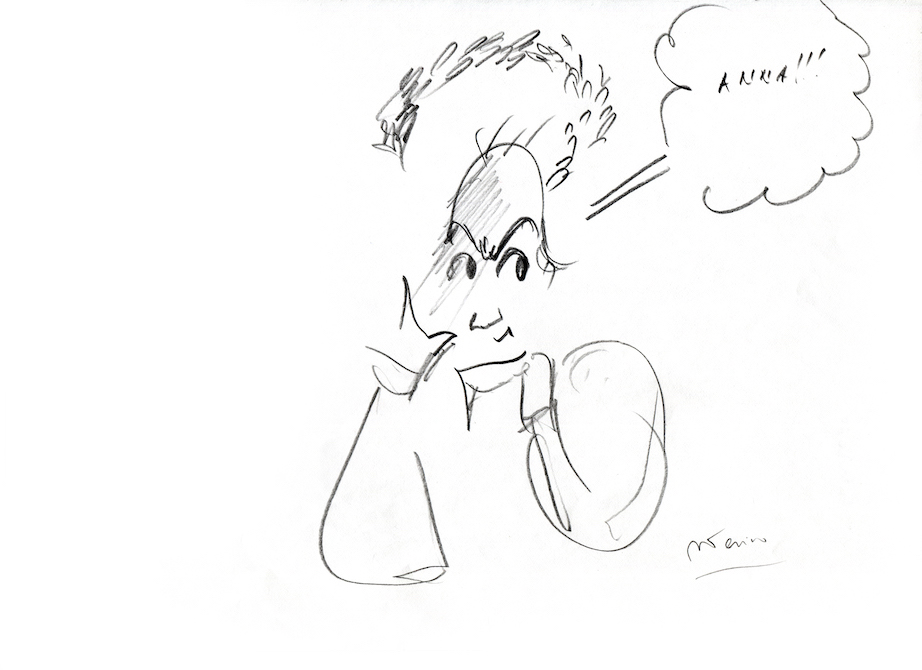
When studying the drawings that Federico Fellini created after the stroke, what is immediately striking from an artistic perspective is how each figure is alive with sensuality and full of movement. Fellini’s figures are in a state of gesture and action. His figures do not have two feet fully on the ground.
The body weight rests on one foot. One leg is in the air, being in an upward or downward movement. The figures radiate energy and vibration. The lines in the drawings express Fellini’s thoughts full of immediacy. Anatomical correctness is not important to Fellini. This would stiffen the spirit. The physicality of the figures lies in the spontaneity of the line. His figures charge, they take a stance. They have courage. They are a sensation emanating outward from a source. The figures come alive on paper directly in front of Fellini. What Federico Fellini cannot do physically, he does on paper through images. His autonomy of movement is now in his hands and lives through line on paper.
The figures in the drawings move when Fellini cannot move. They dance when Fellini cannot dance. They share the sensuality of the human physical form and the life verve that motivates autonomy and the desire for connection from Fellini’s body in his hospital room out into the world. For Fellini there is no other life. Physicality of movement and autonomy over movement is a means of connection and life force for Fellini. Drawing propels Fellini’s life force out into the world…
Practical info: The exhibition runs until April 30, 2023. Opening times: Wednesday to Friday: 16h-20h. Saturday 14h-18h. Sunday 11h-15h, www.fondation-fellini.ch
Location: MAISON DU DIABLE, ESPACE CULTUREL DE LA FONDATION FELLINI, Rue des Creusets 31, 1950 Sion, Switzerland

